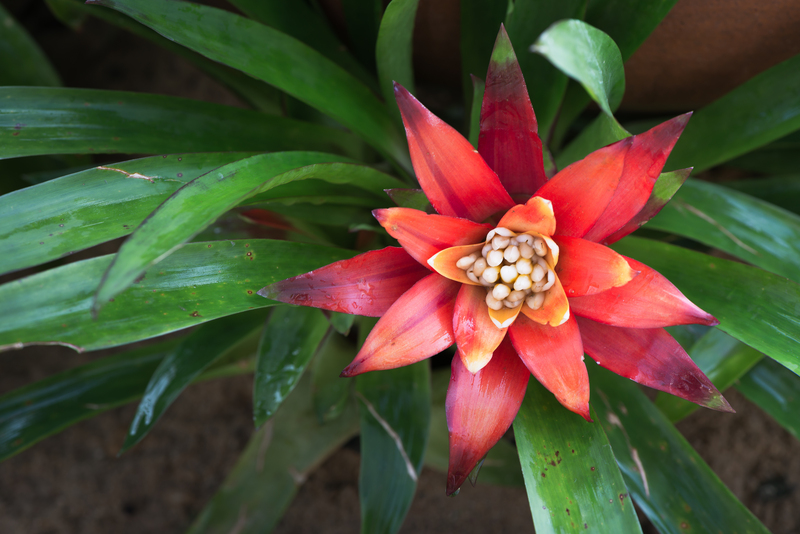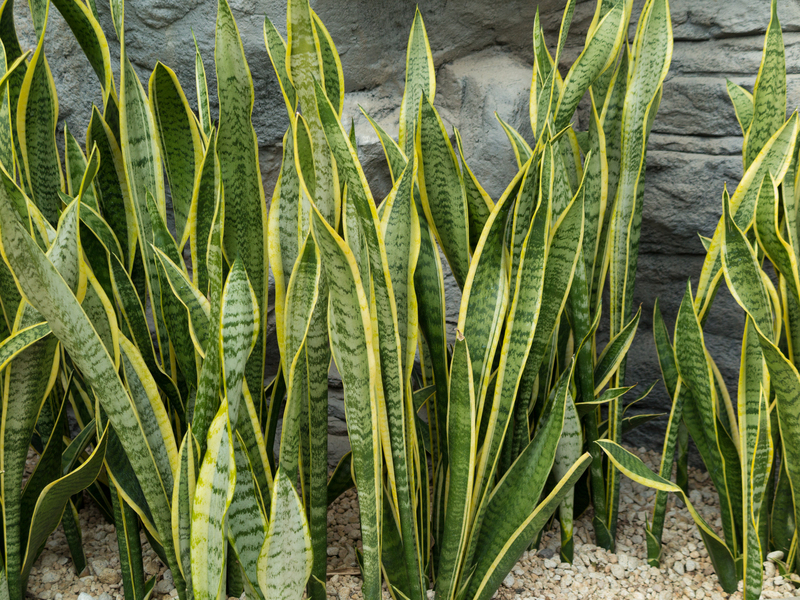Exploring the Rise of Vertical Gardening
Posted on 15/08/2025
Exploring the Rise of Vertical Gardening
Urbanization, shrinking living spaces, and growing sustainability movements are transforming the way we approach gardening. One remarkable trend--vertical gardening--is revolutionizing both private and public spaces worldwide.
What is Vertical Gardening?
Vertical gardening refers to the practice of growing plants on vertically suspended panels or structures, as opposed to traditional horizontal gardens. This innovative approach can utilize a variety of frameworks, such as walls, fences, or purpose-built towers, and is suitable for ornamental plants, edibles, and even lush mossy landscapes. In essence, it's about making the most of limited space by turning unused vertical surfaces into abundant greenery.

The History and Evolution of Vertical Gardening
While vertical gardening techniques may seem like a modern solution, they've deep roots in history. Ancient civilizations, including the Babylonians with their Hanging Gardens, and indigenous communities using living walls, set the precedent for today's green innovations. However, the contemporary rise of vertical gardening is closely tied to the need for space-efficient solutions in rapidly urbanizing environments.
- Ancient Inspirations: The Hanging Gardens of Babylon, one of the Seven Wonders of the Ancient World, showcased breathtaking vertical plantings.
- Modern Innovations: Modern architects and horticulturists draw inspiration from the past while leveraging technology for advanced urban greening solutions.
Key Factors Fueling the Popularity of Vertical Gardening
Several impactful trends and concerns underpin the recent surge of interest in vertical growing systems:
- Urban Densification: As city populations swell, available garden space shrinks. Vertical gardens make it possible to grow plants in apartments, balconies, and rooftops.
- Sustainability: The emphasis on eco-friendly living motivates people to reduce their carbon footprint through local food production and enhanced biodiversity.
- Health and Wellbeing: Green spaces are known to reduce stress, boost mood, and improve air quality, which is particularly vital in urban areas.
- Technological Advancements: Hydroponics, modular planters, and smart irrigation systems make vertical gardens more accessible and easier to maintain.
Benefits of Vertical Gardening
The advantages of vertical gardens extend well beyond just aesthetics. Here are some significant benefits:
- Space Optimization: Perfect for small urban spaces, vertical gardens maximize your growing area by utilizing walls and unused surfaces.
- Improved Air Quality: Plants naturally filter pollutants and toxins from the air, contributing to a healthier indoor and outdoor environment.
- Reduced Urban Heat: Green walls help insulate buildings and reduce the urban heat island effect, offering natural cooling benefits.
- Biodiversity Enhancement: Vertical gardens attract birds, butterflies, and beneficial insects into cityscapes or home gardens.
- Food Security: Urban dwellers can grow their own vegetables and herbs, fostering resilience and reducing reliance on long-distance food chains.
- Noise Reduction: Dense vegetation absorbs and deflects noise, improving acoustic comfort in neighborhoods and workplaces.
Environmental Impact of Vertical Gardens
The growing prevalence of vertical gardens in city landscapes has shown notable environmental benefits:
- Stormwater Management: Vertical gardens can retain rainwater, reducing runoff and alleviating pressure on urban drainage systems.
- Microclimate Regulation: These gardens regulate humidity and temperature, making buildings more energy-efficient.
- Cleaner Cities: With increased plant coverage, cities can combat air pollution and create pleasant, sustainable environments for residents.
Types of Vertical Gardening Systems
Vertical gardening can be tailored to fit virtually any space, style, or need. Here are some of the most popular systems:
1. Green Walls (Living Walls)
- Definition: Purpose-built structures covered in plants, either attached to indoor or outdoor building walls.
- Features: Often integrate automated irrigation and fertilization; ideal for transforming urban buildings into living art pieces.
-
Best For: Offices, public buildings, hotels, municipal spaces, and eco-conscious homes.
Benefits also include improved insulation, increased property value, and a dramatic visual impact.
2. Vertical Planters and Towers
- Definition: Freestanding columns, shelves, or stackable planters designed for patios, balconies, and interiors.
- Features: Portable, flexible, and available in different materials (plastic, fabric, wooden, metal).
- Best For: Home gardeners, apartment dwellers, educational projects, and urban community gardens.
3. Trellises and Espaliers
- Definition: Frameworks that support climbing plants or trees trained to grow flat against a wall.
- Features: Simple, affordable, and excellent for flowering vines, tomatoes, beans, and fruit trees.
- Best For: Traditional gardens, courtyards, and boundary fences.
4. Hydroponic and Aeroponic Systems
- Definition: Soil-less vertical gardens that use nutrient-rich water or mist to feed plants.
- Features: Efficient, high-yield, and space-saving, with minimal water usage.
- Best For: High-tech gardening enthusiasts, commercial vertical farms, and sustainable developments.
Choosing the Right Plants for Vertical Gardens
Selecting the appropriate plant varieties is crucial for a lush, thriving vertical garden. Factors include light availability, climate, irrigation system, and maintenance level. Consider the following categories:
- Ornamental Foliage: Ferns, philodendrons, pothos, ivies, and succulents create beautiful, low-maintenance green walls.
- Flowering Plants: Impatiens, begonias, petunias, and jasmine add vibrant color and fragrance.
- Herbs: Basil, mint, cilantro, parsley, and thyme thrive in vertical planters and offer fresh flavors for culinary use.
- Vegetables: Lettuce, spinach, chard, tomatoes, peppers, and beans are productive in vertical vegetable gardens.
- Fruit-bearing Vines: Strawberries, raspberries, grapes, and passionfruit can climb trellises or spill from pocket planters.
Tip: Choose native and low-maintenance species whenever possible to foster a resilient, self-sufficient vertical ecosystem.
Step-by-Step Guide: How to Start Your Own Vertical Garden
Ready to join the vertical gardening revolution? Here's a straightforward guide for beginners:
- Evaluate Your Space: Measure available walls, fences, or balconies. Check sun exposure and water access.
- Select Your System: Decide between a DIY setup (shelves, trellises, hanging pockets) or commercial kits (living wall panels, hydroponic towers).
- Choose Plants: Match plant selection to your light, climate, and care level.
- Install the Structure: Follow instructions carefully to ensure stability and safe mounting--especially on building exteriors.
- Set Up Irrigation: Traditional pots require manual watering, but larger systems benefit from drip lines or automated irrigation.
- Plant and Arrange: Place plants according to their light and water needs--tallest below, low-light plants at the bottom, sun-lovers at the top.
- Maintain Regularly: Prune, feed, and monitor for pests to ensure your green wall's ongoing health.
DIY Tips for Successful Vertical Gardening
- Recycle and Upcycle: Use old pallets, shoe organizers, or rain gutters for cost-effective and sustainable vertical gardens.
- Invest in Quality Soil: Ensure proper drainage to prevent root rot; lightweight growing mediums are recommended for wall gardens.
- Monitor Watering: Vertical gardens can dry out faster, so check soil moisture frequently.
- Rotate and Refresh: Swap out tired or struggling plants with healthy new ones for continual vibrancy.
Innovative Applications of Vertical Gardens
The versatility of vertical gardening systems opens up creative possibilities:
- Urban Agriculture: Rooftop and wall farms provide fresh produce for restaurants, schools, and communities.
- Interior Design: Living art installations and green partitions redefine home and office aesthetics.
- Public Spaces: City planners incorporate green facades on buildings, walkways, and shopping centers.
- Therapeutic Gardens: Hospitals and care homes use vertical gardens to promote healing and well-being.
- Climate Adaptation: Green infrastructure helps cities combat flooding, heat, and air pollution.
Case Studies: Vertical Gardens Making a Difference Worldwide
From Singapore's striking "Supertree Grove" and Paris's lush green facades to New York's interior vertical farms, the impact of vertical gardening is undeniable:
- Singapore: The city's commitment to 'biophilic' urban design is evident in hundreds of buildings wrapped in living greenery.
- Europe: Cities like Milan and London are integrating green walls as part of air quality and sustainability initiatives.
- United States: Urban vertical farms in cities like New York and Chicago provide fresh local produce and job opportunities.
Challenges and Considerations with Vertical Gardening
While the rise of vertical gardening offers many benefits, practitioners must be mindful of several challenges:
- Initial Cost: High-tech living walls can be expensive to design, install, and maintain.
- Structural Load: Additional weight on walls or fences requires proper assessment to avoid damage.
- Water Management: Vertical setups can experience uneven watering; automated systems can help regulate moisture.
- Pest and Disease Control: Dense plantings may harbor pests--regular monitoring is key.
- Plant Selection: Selecting unsuitable species can lead to maintenance headaches and poor results.
With thoughtful planning and regular care, these challenges can be mitigated, unlocking the full potential of vertical gardens.

The Future of Vertical Gardening
Experts predict that the vertical gardening trend will only continue to grow as cities seek sustainable solutions for food security, climate adaptation, and quality of life. Ongoing research focuses on new materials, energy-efficient irrigation, edible plant breeding, and even integration with renewable energy sources such as solar panels.
Innovators aim to make vertical gardening more affordable, accessible, and scalable, not only for urban luxury but as a vital tool for a resilient, green future.
Conclusion: Embracing the Vertical Green Revolution
From compact balconies to breathtaking skyscrapers, vertical gardening is reshaping how we connect with nature in built environments. With benefits spanning environmental sustainability, food production, health and well-being, and pure enjoyment, this green revolution offers solutions for gardeners, architects, and city planners alike.
By understanding the diversity of vertical gardening systems, their unique advantages, and practical considerations, anyone can join this vibrant movement and help pioneer greener, more livable cities for generations to come.
Are you ready to take your garden to new heights? Explore the endless possibilities of vertical gardening and make your space thrive--upwards!



